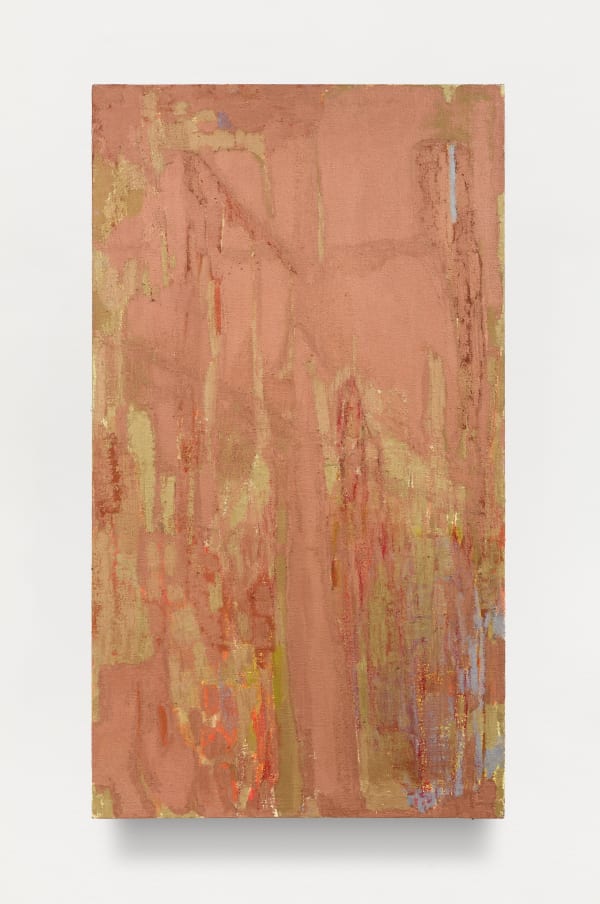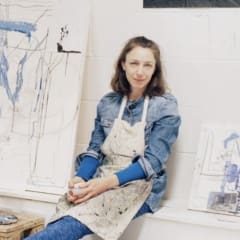Nocturnal Music Varda Caivano
Mendes Wood DM is pleased to present Nocturnal Music, Varda Caivano’s inaugural New York solo exhibition. Caivano, whose painterly mark is defined by abstraction, experimentation, and studies of light, approaches art as laboratory work where thinking becomes making, with the studio process remaining the most important aspect of her practice. Her ideas are experienced through a relationship with the object, emphasizing direct material encounters. Working with charcoal wash, oil, and oil stick on jute and velvet, the artist engages materials through layered, iterative processes. Oil transforms between states – dust, liquid, waxy substances – changing its condition while remaining essentially the same. Velvet emerges as particularly resistant in this new body of work, with silk velvet chosen over mass-produced analogs. The pressure and direction of her mark determine whether a certain color is seen or not. In this way, Caivano cultivates a live relationship with materials. Working with velvet and metallic colors proves both evasive and rewarding as each follows its own personality and set of rebellious traits.
The works in Nocturnal Music register resistance on a near-molecular level, recording actions and revisions through material friction, with earlier layers leaving behind visible traces. Caivano often works on multiple canvases simultaneously, applying successive layers to build complex surfaces. Colors emerge through layering, more prominently in some paintings than others. Initially, the artist researched velvet and metallic coloration independently before connecting their shared material resistance, now embracing it as a creative agent in this exhibition. The paintings function as transitional spaces or bridges – not closed, but working actively in the viewer’s perception. The artist maintains that the works remain purposefully open, created without a specific method to reach a predetermined experience for the viewer.
Caivano’s paintings dry into a certain form; what remains vital is the studio process where materials and the artist negotiate distinct moments. Although non-figurative and always untitled, the works frequently conjure and communicate geometries, points of focus, ideas without literal depiction. Forms emerge and recede, presenting themselves as vulnerable, unfolding, failing, resilient. Among diverse inspirations, American abstraction has been on Caivano’s mind around Nocturnal Music – particularly the rigorous and often underrecognized contributions of women artists. Jazz, too, provides a model of a creative framework open to free composition. Caivano frequents jazz clubs, where the dynamics of ensemble improvisation – responsive, unstable, unresolved – inform how she works. Just as each jazz musician asserts an individual sound through touch, phrasing, and timing, her marks negotiate their own material presence. The performance itself becomes central to the experience – shaped by failure and fluency. The feedback loop between structure and risk in jazz, and its refusal of fixed resolution, resonates through the paintings.
Alongside music, she draws parallels between her approach and poetry, noting that a poem is not simply the result of words placed together but shaped and received beyond language. On a visual plane, Caivano’s paintings demand active engagement to reveal values and resonances from pellucid surfaces.
Varda Caivano (b. 1971, Buenos Aires, Argentina) lives and works between London and Madrid.
Her recent solo exhibitions have been held at Mendes Wood DM, New York (2025); Labor, Mexico City (2024); Mendes Wood DM, Brussels (2022); Lulu by X Museum, Mexico City (2022); Mendes Wood DM, São Paulo (2021); Tomio Koyama Gallery, Tokyo (2019); The Renaissance Society, Chicago (2015); Victoria Miro, London (2011); Chisenhale Gallery, London (2007); Kunstverein Freiburg, Freiburg (2006).
Her recent group shows have been held at Green Family Art Foundation, Dallas (2025); Mendes Wood DM at d’Ouwe Kerke, Retranchement (2024 & 2022); Lisson Gallery, London (2024); Spiral Garden, Tokyo (2022); Zabludowicz Collection, London (2020); Hayward Gallery Touring, Leeds Museum and Art Gallery, Leeds; Levinsky Gallery, The Arts Institute – University of Plymouth, Plymouth; University of Bath and Bath Spa School of Art and Design, Bath; Inverness Museum & Art Gallery, Inverness; Thurso Art Gallery, Thurso (2019); National Museum of Art, Osaka (2018); Nottingham Contemporary, Nottingham (2014); 55th International Art Exhibition, La Biennale di Venezia, Venice (2013); Nottingham Contemporary, Nottingham; Hayward Gallery, London; Glasgow Centre for Contemporary Art, Glasgow; Plymouth Arts Centre, Plymouth (2010).
-
 Varda Caivano, Untitled, 2025
Varda Caivano, Untitled, 2025 -
 Varda Caivano, Untitled, 2025
Varda Caivano, Untitled, 2025 -
 Varda Caivano, Untitled, 2025
Varda Caivano, Untitled, 2025 -
 Varda Caivano, Untitled, 2025
Varda Caivano, Untitled, 2025 -
 Varda Caivano, Untitled, 2025
Varda Caivano, Untitled, 2025 -
 Varda Caivano, Untitled, 2025
Varda Caivano, Untitled, 2025 -
 Varda Caivano, Untitled, 2025
Varda Caivano, Untitled, 2025 -
 Varda Caivano, Untitled, 2025
Varda Caivano, Untitled, 2025 -
 Varda Caivano, Untitled, 2025
Varda Caivano, Untitled, 2025 -
 Varda Caivano, Untitled, 2025
Varda Caivano, Untitled, 2025 -
 Varda Caivano, Untitled, 2025
Varda Caivano, Untitled, 2025 -
 Varda Caivano, Untitled, 2025
Varda Caivano, Untitled, 2025 -
 Varda Caivano, Untitled, 2025
Varda Caivano, Untitled, 2025 -
 Varda Caivano, Untitled, 2025
Varda Caivano, Untitled, 2025 -
 Varda Caivano, Untitled, 2025
Varda Caivano, Untitled, 2025 -
 Varda Caivano, Untitled, 2025
Varda Caivano, Untitled, 2025 -
 Varda Caivano, Untitled, 2025
Varda Caivano, Untitled, 2025 -
 Varda Caivano, Untitled, 2025
Varda Caivano, Untitled, 2025 -
 Varda Caivano, Untitled, 2025
Varda Caivano, Untitled, 2025





















